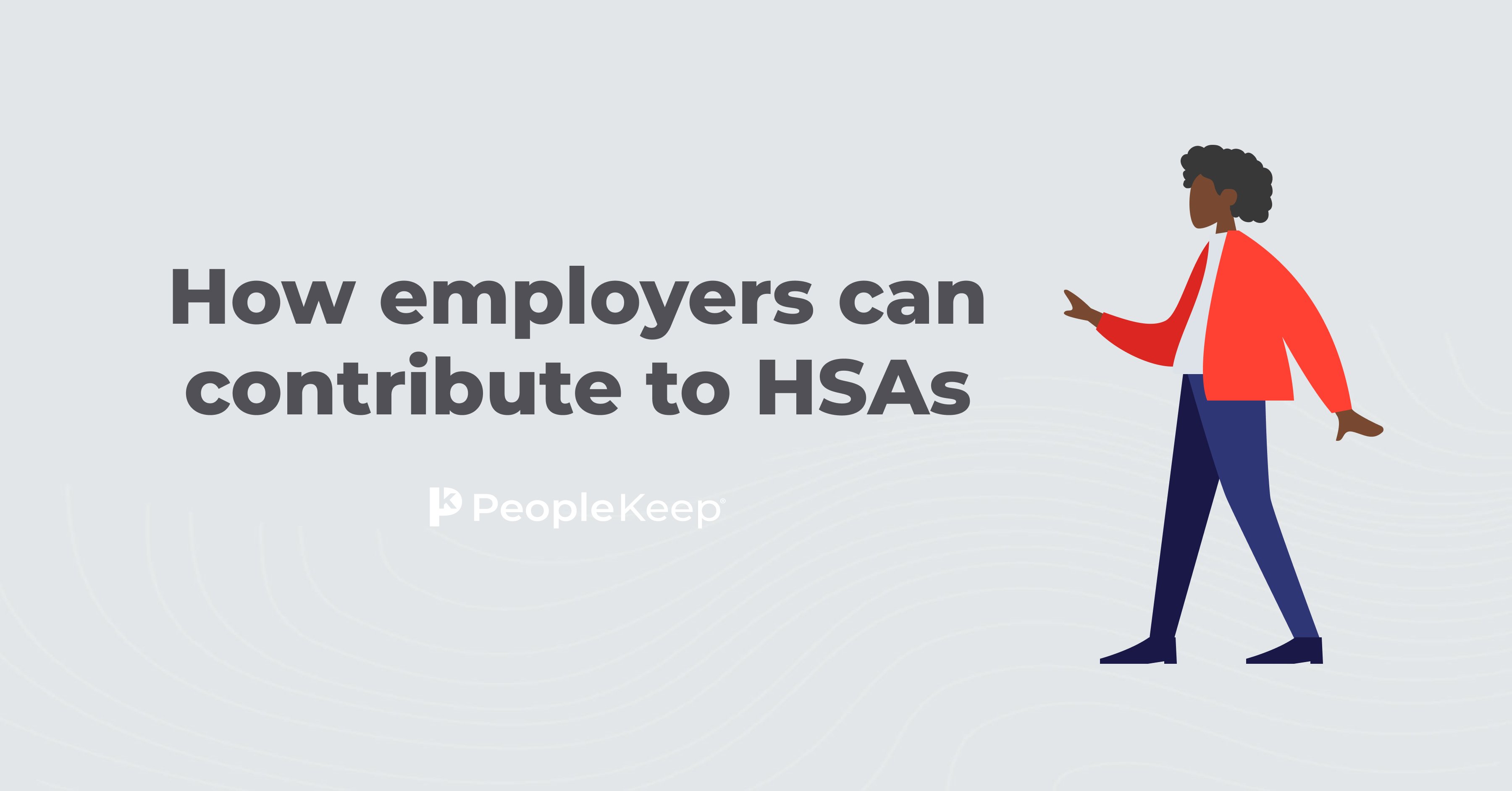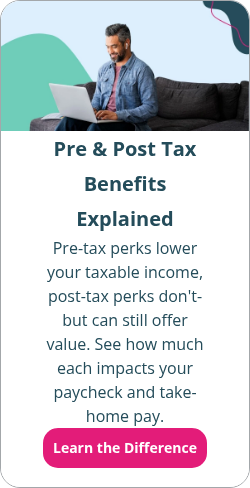What is a section 125 plan?
By Elizabeth Walker on August 26, 2024 at 10:22 AM
If you’re an employer in the process of building a total compensation package, you may have run across benefits that are considered Section 125 plans. A Section 125 plan, also known as a cafeteria plan, allows you to boost your compensation package in a cost-effective way while enjoying certain tax advantages.
Employers competing for top talent can offer health insurance, financial assistance for child care, and even certain fringe benefits under Section 125 plans to help attract and retain employees. With a cafeteria plan, you can increase your employees’ total compensation without increasing their tax liability.
In this article, we’ll take a deep dive into Section 125 benefit plans to help you better understand how they work for employers and employees.
In this blog, you’ll learn:
- How a Section 125 plan works.
- The different types of Section 125 plans.
- Which employee benefits are an alternative to Section 125 plans.
What is a Section 125 plan under the tax code?
Under Section 125 of the Internal Revenue Code, a Section 125 plan enables employees to take a taxable portion of their total compensation—like their cash salary—and receive it as a pre-tax qualified benefit.
According to the Internal Revenue Service, the following qualified benefits are Section 125 plans1:
- Health insurance premiums (medical, dental, and vision)
- Accident and disability coverage
- Retirement deposits
- Adoption assistance
- Dependent care assistance
- Group-term life insurance coverage
- Health savings accounts (HSAs)
Section 125 plans are tax-advantaged. Because they are funded using pre-tax deductions, an employee’s taxable income decreases by the amount they use toward cafeteria plan contributions.
This means the employee will pay fewer federal income, Medicare, and Social Security taxes. Depending on their location, employees participating in these types of plans can save between 28% and 48% in total federal, state, and local taxes on the portion of their income that goes toward cafeteria plan contributions.
Pre-tax deductions also reduce the employer’s FICA and FUCA tax liabilities. Plus, the employer can save an extra 7.65% on their payroll taxes.
Types of section 125 employee benefit plans
|
Plan type |
Plan description |
|
Full-flex cafeteria plan |
With a full-flex cafeteria plan, employers make a non-elective contribution for each eligible employee. Employees can spend their employer’s contribution to buy any qualified benefit offering within the plan. The employee may also contribute pre-tax money to buy additional benefits besides what the employer contributes. |
|
Simple cafeteria plan |
Employers with fewer than 100 employees may qualify for a simple cafeteria plan as long as the nondiscrimination requirements of a full-flex cafeteria plan apply. A plan qualifies as a simple cafeteria plan if it meets specific contribution, eligibility, and participation rules. |
|
Premium-only plan (POP) |
POPs are one of the most common types of Section 125 plans. They allow employees to pay their health insurance premiums with tax-free dollars. As the name suggests, these premiums are the only expenses POPs can cover. The premiums can be for employer-sponsored insurance plans or individual health policies. A POP can include a “cash-in-lieu of benefits” provision. Employees enrolled in another group health plan, like a spouse’s plan, can choose to receive a fixed amount of cash instead. With this option, the cash amount is a taxable benefit. |
|
A healthcare FSA is a savings account allowing employees and employers to make tax-free contributions that employees can use to pay for healthcare costs. Another plan type is a dependent-care FSA, which pays for certain dependent care costs, like childcare expenses and elder care. |
|
|
Health savings account (HSA) |
An HSA is a savings account in which employees can save money tax-free for future medical expenses. Employers can also contribute to an HSA. An HSA is only a Section 125 plan when employers sponsor the benefit. |
Like most benefits, a Section 125 plan doesn’t require employee participation. Some employees may choose not to exchange a portion of their taxable wages for tax-free benefits. However, setting aside pre-tax dollars to pay for a wide variety of benefits is an appreciated perk for many individuals. It can improve satisfaction, morale, and retention.
Who can participate in a Section 125 plan?
Now that you know more about Section 125 plans, let’s look at their participation requirements. Only employers can sponsor a Section 125 plan, but they’re available to eligible employees, their spouses, and their dependents.
Section 125 plans may also include former employees, depending on the plan design. However, the plan can’t be primarily for them.
Any company with employees subject to federal income taxes in the U.S. can sponsor a Section 125 plan, including the following:
- C corporation
- S corporation
- Limited liability company (LLC)
- Partnership
- Sole proprietorship
- Government entity
Certain people can’t participate in Section 125 plans. These include self-employed individuals, partners within a partnership, and shareholders who own more than 2% of a subchapter S corporation.
How much does a Section 125 plan cost?
Setting up plan documents and forms for your Section 125 plan is vital. If you use an attorney or tax advisor, costs are typically between $100 and $600, depending on your third-party administrator (TPA), broker, insurance agent, or tax advisor. However, the initial fee is small compared to the plan’s significant long-term tax savings.
A broker or TPA can help you stay on top of updates and regulatory changes that may affect your applicable plan documents. It’s worth the cost to have ongoing help handling any changes to your benefit if you need to update it according to current cafeteria plan regulations to stay compliant.
How do you set up a Section 125 plan?
Creating and maintaining your cafeteria plan benefit requires careful ongoing care. But a few tips can help you get started.
Follow these three steps to starting a Section 125 plan:
- Complete the necessary plan documents.
- Notify employees that you are offering a Section 125 cafeteria plan.
- Hire a third-party administrator to manage your Section 125 plan and process reimbursements.
Once you start offering your plan, conduct nondiscrimination testing annually. You should keep all your test results on file in case of an audit.
Your organization’s plan must pass the following three nondiscrimination tests:
- Eligibility: Your plan design can’t make it easier for your company’s highest-paid key employees to participate.
- Benefits and contributions: The benefits and contributions you offer must favor employees of all compensations equally.
- Concentration: The value of the benefits for your key employees must be at most 25% of the value of all your employees’ benefits.
What is a health benefit alternative to Section 125 plans?
If a Section 125 plan doesn’t seem like the right fit for your organization, you have other options. A Section 105 medical reimbursement plan may be your best bet. Health reimbursement arrangements (HRAs) are a simple and flexible way for employers of all sizes to offer their employees a pre-tax benefit.
An HRA allows you to reimburse employees for their out-of-pocket medical expenses and individual health insurance premiums. Unlike HSAs, only employers may contribute. But you don’t need to pre-fund the benefit.
You start by setting a monthly allowance that employees can use on healthcare services and items. Once your employees buy an eligible expense and submit proof of purchase, you reimburse them tax-free up to their allowance amount.
HRA funds stay with you until reimbursement. If an employee leaves your company, the benefit stays with the employer, lowering your financial risk.
Whether you’re offering a qualified small employer HRA (QSEHRA) or an individual coverage HRA (ICHRA), when it comes to premiums, you have two main options for setting up your plan: premium-only and premium-plus.
Let’s review each plan type in more detail to help you decide which is best for you and your employees.
Premium-only HRAs
A premium-only HRA is like a Section 125 POP—employees can only use it to pay for qualifying insurance premiums. This generally includes individual health insurance policies that qualify as minimum essential coverage (MEC). You can also reimburse employees with MEC for ancillary and supplemental health plan premiums. The difference between a premium-only HRA and a POP is that funds only come from the employer on a reimbursement basis.
Employers with a QSEHRA can also choose if they want to reimburse employees for their spouse’s employer-sponsored group insurance premiums. If so, the Internal Revenue Service considers this reimbursement taxable because the employee’s spouse is likely making a pre-tax payroll deduction to pay for the premiums.
A premium-only HRA is best for you if:
- You want to help your employees pay for healthcare but don’t have the budget to cover out-of-pocket costs.
- You have many employees with an individual health insurance policy.
- You have many employees paying multiple health insurance premiums (i.e., health, dental, and vision).
If you’re considering a premium-only HRA for budgetary reasons, simply lowering your HRA benefit allowance on a premium-plus HRA is another alternative. That way, your employees can still choose how to spend their allowance, such as if they’d rather get reimbursed for out-of-pocket expenses instead of premiums.
Premium-plus HRAs
Another benefits package option you have available is a premium-plus HRA. A premium-plus HRA reimburses employees for the same qualifying health insurance premiums as a premium-only plan while reimbursing employees for eligible, qualified expenses.
Eligible expenses include prescription drugs, chiropractic services, mental healthcare, ambulance services, and other medical items. All expenses in IRS Publication 502 are reimbursable with a premium-plus HRA.
A premium-plus HRA is best for you if:
- You offer a QSEHRA and have many employees on a spouse’s or parent’s plan who don’t need reimbursement for health insurance premiums.
- You have the budget to reimburse more than just health insurance plan premiums.
Integrated HRAs
Suppose you’re already offering your employees a group health insurance policy but also want to cover the out-of-pocket healthcare costs that the group plan doesn’t fully cover. In that case, the integrated HRA is for you.
An integrated HRA, or group coverage HRA (GCHRA), is the only HRA that exclusively covers out-of-pocket costs, not health insurance premiums, making it the perfect choice for employers looking to supplement their group health insurance plan. GCHRAs also don’t have minimum or maximum contribution limits, so you can offer as much allowance as your budget allows.
With an integrated HRA, employees can get tax-free reimbursements for qualified expenses not fully paid for by the group plan. However, only employees enrolled in your company’s group health coverage can participate in the benefit.
Conclusion
Having access to flexible benefits remains a top priority for employees. Section 125 plans are popular because they allow you to offer qualified benefits that entice workers while reducing tax liabilities for you and your employees. But if they’re not for you, HRAs are great alternative benefit options.
Choosing between a premium-only or premium-plus HRA is one of the many ways you can customize your health benefit to suit your needs. Schedule a call with a PeopleKeep HRA specialist to determine which type of HRA is best for your organization.
This article was originally published on January 27, 2015. It was last updated on August 23, 2024.
References
1. https://www.law.cornell.edu/uscode/text/26/125
Check out more resources
See these related articles

Types of employee reimbursements
Explore the different types of employee reimbursements, like travel, healthcare, and more. Learn how reimbursements benefit both employees and employers.

How employers can contribute to HSAs
This blog will define HSAs, discuss how employers can contribute to an HSA, and provide other health benefit options.

How much do employers pay for health insurance?
In this blog, we’ll break down the average cost of health insurance per employee as well as the average cost of employer-provided group health insurance.




